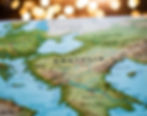History of Turkey: Unraveling Centuries of Cultural Wonders
- Vanessa Chamma
- 20 de fev.
- 12 min de leitura
Atualizado: 8 de jul.
The history of Turkey is a fascinating journey through time, marked by significant events and cultural milestones. Nestled between Asia and Europe, Turkey has been a bridge of civilizations. Its strategic location has made it a key player in history, shaping the paths of empires and nurturing diverse cultures.
Middle East | History of Turkey

Dating back to ancient times, the lands of Turkey have seen the rise and fall of empires like the Greeks, Romans, and Byzantines. The Ottoman Empire, one of the most splendid and long-lasting empires, left a significant mark on Turkey and the world. This era is renowned for its architectural wonders, vibrant cultures, and the blending of diverse traditions.
In the modern era, Turkey transformed significantly, emerging as a dynamic republic under the leadership of Mustafa Kemal Atatürk. Today, Turkey stands as a testament to the rich tapestry of its past, forging ahead with cultural vibrancy and robust geopolitical dynamics.
Key Takeaways
Turkey is a pivotal link between Europe and Asia.
The Ottoman Empire greatly influenced Turkish culture.
Turkey's modernization began with Atatürk's reforms.
Geographical and Ancient Roots

Turkey's unique location has made it a hotbed of ancient cultures and empires, which have all left their marks on its lands. The region of Anatolia, rich in prehistoric wonders, hosted many civilizations, such as the Hittites and Phrygians, each woven into its intriguing history.
Ancient Anatolia and Early Civilizations
Anatolia, now part of modern Turkey, was home to some of the earliest human settlements. The Hittites, known for their advanced society, ruled major parts of this region around the 17th century BCE. Their capital, Hattusa, was a bustling center of trade and culture.
The Urartians later rose to power in Eastern Anatolia, leaving behind impressive monuments and fortresses. Meanwhile, Phrygians occupied the central parts and were famous for their legendary King Midas, often romanticized for his golden touch. The Lydians, known for introducing coinage, thrived in Western Anatolia, further shaping the area's development. The legendary Trojan War also took place here, immortalizing the city of Troy in both history and myth.
Influence of Empires
Various empires left their influences on this land, shaping its history and culture. The region became part of empires like the Persian Empire, which expanded into Anatolia in the 6th century BCE. Their influence reached into local science and architecture, leaving a lasting impact.
Following them, the conquest by Alexander the Great brought Hellenistic culture, seen in many ancient ruins scattered across Turkey. Later, the Romans emerged, turning Anatolia into a province within a vast empire that introduced infrastructure like roads and aqueducts. These successive empires molded the region's cultural and political landscape, making it a tapestry of historical narratives.
Classical Antiquity to the Middle Ages
Explore the vibrant history of Turkey through its classical and medieval periods. This journey encompasses conquest, empire-building, and cultural shifts, set against the backdrop of famous cities and powerful empires.
Alexander the Great

In the classical era, Alexander the Great played a pivotal role in shaping Anatolia's history. Born in 356 BCE, he became king of Macedon and set out to build a vast empire. His invasion of Anatolia in 334 BCE marked the beginning of Greek influence in the region. Cities like Ephesus and Pergamon flourished under Hellenistic culture, becoming centers of art and learning.
Alexander's conquests extended beyond Turkey, reaching as far as Egypt and India. Although his reign was short-lived, his impact was lasting. His empire fragmented after his death in 323 BCE, leading to the rise of the Hellenistic Kingdoms and further cultural blending.
Roman and Byzantine Rule

After Alexander, the Roman Republic expanded into Anatolia, eventually transforming into the Roman Empire. By 300 CE, it included much of modern-day Turkey. This time saw significant development, including the founding of Constantinople in 330 CE by Emperor Constantine, which became a major cultural and political hub.
The Byzantine Empire emerged as the Greek-speaking continuation of the Eastern Roman Empire, lasting for over a thousand years. Notable moments include Emperor Justinian I's reign, during which he codified Roman law and oversaw the construction of landmarks like the Hagia Sophia. The Council of Nicaea in 325 CE, a key Christian event, also took place during this period.
Rise of the Seljuk Turks
The arrival of the Seljuk Turks in the 11th century marked a significant shift. Originally migrating from Central Asia, they gradually conquered much of Anatolia. Their victory at the Battle of Manzikert in 1071 against Byzantine forces opened the region to Turkish control. The Seljuks founded the Sultanate of Rum, establishing Nicaea as their initial capital.
Under the Seljuks, Anatolia experienced cultural and economic growth, with influences from Persia and Central Asia. Their architectural achievements included impressive mosques and caravanserais. Their rise precipitated further changes in the region, leading to the eventual emergence of the Ottoman Empire.
The Splendid Ottoman Era

The Ottoman Empire, known for its vast reach and cultural influence, experienced significant growth and change. From its foundation to its peak under Suleiman the Magnificent, the empire's story is marked by impressive conquests, brilliant leadership, challenges, and reforms.
Foundation and Expansion
The Ottoman Empire was founded in the late 13th century by Osman I, a leader of the Ottoman Turks. Emerging from the decline of the Seljuq dynasty, these Turkic warriors took advantage of the Battle of Manzikert to expand their territory. Early Ottoman sultans like Mehmed I continued this legacy, consolidating power and paving the way for future victories.
A turning point came with Sultan Mehmed II, also known as Mehmed the Conqueror. In 1453, he captured Constantinople, transforming it into a bustling capital and a symbol of Ottoman might. His reign marked a period of aggressive expansion into Europe and Asia. Through strategic prowess and military strength, the Ottomans established a vast empire that would influence global history for centuries.
Suleiman the Magnificent and the Golden Age

Suleiman the Magnificent reigns supreme in the Ottoman Empire's history. Under his leadership, the empire reached a cultural and military zenith, often referred to as the Golden Age. He expanded the empire's borders significantly, dominating parts of Europe, Asia, and Africa. Cities like Baghdad and Belgrade fell under Ottoman control during his rule.
Suleiman was not just a conqueror but also a patron of the arts. His reign saw flourishing literature, architecture, and music. The iconic Suleymaniye Mosque in Istanbul stands as a testament to his and the empire's architectural grandeur. Legal reforms during his era also contributed to a more organized administrative structure, creating a long-lasting impact.
Challenges and Reforms
Despite its glory, the Ottoman Empire faced numerous challenges. Military setbacks, such as the Crimean War and Russo-Turkish Wars, tested the empire's strength. Internal strife and corruption further weakened its hold.
In response, several sultans implemented reforms. The Tanzimat period in the 19th century introduced significant changes in education, military, and government, aiming to modernize the state. While efforts were made to revive the empire, it faced continual decline, leading to the eventual collapse after World War I. These reforms, however, left a legacy of transformation and adaptation in a rapidly changing world.
Transition and Modernization

Turkey's transition into a modern state was marked by the decline of the Ottoman Empire, the struggle for independence, and the formation of the Republic of Turkey. Key figures like Mustafa Kemal Atatürk played pivotal roles in these historic events that redefined Turkey's identity and governance.
Decline of the Ottoman Empire
The Ottoman Empire faced a significant decline in the late 19th and early 20th centuries, weakening its vast territory. Various internal and external pressures contributed to its downfall. The empire's participation in World War I on the Central Powers' side accelerated its disintegration. Following the Armistice of Mudros, the Ottoman Empire was effectively dismantled, leading many of its regions to gain independence or fall under foreign occupation.
Financial difficulties and military defeats further strained the empire's hold on power. These issues triggered nationalist movements, pushing for sovereignty and reform. As a direct consequence, regions formerly under Ottoman rule began to assert their independence, seeking either autonomy or complete separation from the empire.
The Turkish War of Independence
Led by Mustafa Kemal, later known as Atatürk, the Turkish War of Independence was a response to foreign occupation and partitioning schemes. This movement, known as the Turkish National Movement, saw fierce battles as locals rose against occupying forces. Atatürk and his supporters formed the Grand National Assembly in Ankara, which became a rallying point for resistance.
This war was not only a struggle against occupying forces but also against the imposition of post-World War I treaties that threatened Turkey's sovereignty. The conflict culminated in the Treaty of Lausanne, which recognized the modern borders of Turkey, securing its place as a sovereign nation. The victory paved the way for sweeping political and cultural changes.
The Birth of the Republic of Turkey
On October 29, 1923, the Republic of Turkey was officially proclaimed, marking a profound shift in the country's governance. Mustafa Kemal Atatürk became the first president and embarked on an ambitious reform agenda. The new Turkish Constitution was established, emphasizing secularism, education, and modernization.
Atatürk's policies focused on creating a unified national identity, separating religion from the state, and introducing economic and social reforms. These changes aimed to transform Turkey into a modern, progressive nation, ensuring its survival and development in the global arena.
Contemporary Turkey
Contemporary Turkey has gone through dynamic political and economic changes. Exploring its journey through multiparty politics, attempts at integration with western entities, and its recent political landscape offers a glimpse into the country's current state.
Multiparty Politics and Military Coups
Following World War II, Turkey transitioned to a multiparty political system, marking a shift from the single-party rule established by Mustafa Kemal Atatürk. This period saw the rise of various parties, but also a series of military coups. The coups in 1960, 1971, 1980, and 1997 were pivotal, as the military saw itself as a guardian of secularism and national unity.
Turkey's political landscape underwent significant transformations, with the Justice and Development Party (AK Party) emerging as a dominant force. Under its leadership, the country experienced marked political and economic shifts while navigating complex relationships domestically and internationally.
Integration with the West
Turkey's desire to align with Western powers was evident post-World War II. The country joined the North Atlantic Treaty Organization (NATO) in 1952, reinforcing its strategic stance during the Cold War. The Truman Doctrine further strengthened ties with the West, ensuring military and financial aid.
Turkey pursued deeper integration with Europe by seeking European Economic Community membership, later the European Union. Although full membership remains elusive, the collaboration has fostered economic growth. Relations have been complex, yet vital, particularly with crucial partnerships in defense and trade.
Recent Political Landscape
In recent years, Turkey has witnessed a turbulent political scene. Under President Recep Tayyip Erdoğan, the country has faced a failed coup attempt in 2016, which resulted in significant political clampdowns and restructuring. Erdoğan's leadership has sparked debates on democracy and governance.
The Syrian Civil War posed challenges for Turkey, affecting its domestic and foreign policies. The country has had a contentious relationship with the Kurdistan Workers' Party (PKK), impacting regional stability. Despite these challenges, Turkey remains a key player in regional and global politics, balancing its role in NATO and alongside EU prospects with domestic aspirations.
Cultural and Historical Significance

Turkey stands as a bridge between continents, rich in history and culture. Its vibrant architecture and religious crossroads have significantly impacted the world, shaping civilizations. The cities of Istanbul and Ankara, in particular, resonate with stories from the Byzantine Empire to modern times.
Religious and Architectural Heritage
Istanbul, formerly known as Constantinople, is a testament to architectural wonder. The Hagia Sophia shines as an example of Byzantine architecture that later became a mosque, highlighting the blend of Christian and Islamic influences. Similarly, the ruins of Ephesus and Smyrna echo early Christianity's roots, showcasing ancient temples and theatres.
Göbekli Tepe uncovers the mysteries of early human religious practices, dating back to 9600 BCE. These sites demonstrate Turkey's role as a sanctuary for numerous faiths and architectural styles, including Ottoman mosques and Byzantine churches, showing a seamless fusion of cultures over millennia.
Impact on Global Civilization
Turkey's pivotal location has shaped global civilization. The rise and fall of the Byzantine Empire and later Turkish influence helped shape European and Asian interactions. Cities like Constantinople were epicenters for trade and diplomacy, connecting the East and the West.
Ankara, the country's capital, symbolizes Turkey's modern strides, while Istanbul serves as a cultural beacon. The country's rich cultural heritage continues to inspire, from historical sites like Ephesus to the bustling cities of today. These elements weave Turkey's unique story and underscore its lasting influence on art, religion, and politics worldwide.
Geopolitical Dynamics and Relations
Turkey's geopolitical landscape is defined by its interactions with neighbors, historical disputes, and its significant influence on the global stage. These dynamics are rooted in both historical events and ongoing strategic interests, impacting regional stability and global relations.
Cyprus and the Aegean Disputes
The tension between Turkey and Greece over Cyprus and the Aegean Sea stems from conflicting territorial claims. This involves issues like maritime boundaries, airspace, and the demilitarization of certain islands.
In Cyprus, the division remains a key point of contention. The island has been split since 1974 when Turkey intervened following a coup. This intervention aimed to protect the Turkish Cypriots from potential Greek dominance. The presence of Turkish troops in Northern Cyprus is still a sensitive subject.
Diplomatic efforts continue, but resolving these disputes remains complex. The Treaty of Ankara and other agreements aim to manage these tensions, yet a lasting solution requires substantial negotiations and confidence-building measures from both sides.
Interactions with Neighboring Countries
Turkey's geographical location places it at a crossroads between Europe and Asia, influencing its relations with neighboring countries. Relations with Greece and Bulgaria in Eastern and Southern Thrace involve both cooperation and competition.
Additionally, Turkey shares a long history with the Persian Empire, impacting its diplomatic ties with modern-day Iran. These interactions include economic collaborations and strategic partnerships, sometimes strained by differing regional objectives.
In the Balkans, Turkey's historical ties with regions like Macedonia shape its diplomatic stance. The Cold War era further complicated these relations, but today's focus is on trade and cultural exchange to foster positive regional relationships. The Treaty of Ankara and similar agreements play critical roles in mediating these interactions and ensuring stability in the region.
Turkey's Role in Contemporary World Affairs
In the modern geopolitical arena, Turkey serves as a bridge between East and West, leveraging its strategic location and historical ties. Turkey plays a pivotal role in organizations like NATO, contributing to regional security and global peacekeeping efforts.
Additionally, Turkey's economic growth propels its influence. Bursa, as an industrial hub, showcases Turkey's economic capabilities. Turkey's energy routes, including pipelines traversing the country, underscore its significance in the global energy market.
Turkey also takes part in peace talks and mediates regional conflicts, using its unique position to facilitate dialogue. Balancing relations with the EU, Cyprus, and other nations, Turkey continues to shape and redefine its geopolitical importance on the world stage.
The books listed below can be purchased on Amazon. Simply click on the book cover and you will be directed to the purchase page. As a participant in the Amazon Associates Program, I receive payments from qualifying purchases.
Frequently Asked Questions
Turkey is a fascinating country with a rich history that includes its transition from the Ottoman Empire, key historical milestones, and its evolving religious and cultural identity.
How did the Republic of Turkey emerge from the Ottoman Empire?
The Republic of Turkey was born from the remnants of the Ottoman Empire. After World War I, the empire's dissolution prompted Mustafa Kemal Atatürk and his fellow nationalists to lead a movement for independence. In 1923, the Republic of Turkey was officially established, with Ankara as its capital, marking a new era of modernization and reform.
Can you unveil the milestones of Turkey's historical timeline?
Important milestones in Turkey's history include the founding of Constantinople in 330 AD, its capture in 1453 by the Ottomans, and the eventual founding of the Republic in 1923. Key events shape the narrative of Turkey's political and cultural evolution over time. Each period has had a significant impact on the country's development.
What are some astonishing facts about Turkey's rich history?
Turkey's history features cities like ancient Troy and Pergamon. The Acropolis of Pergamon is noted for its astounding Hellenistic architecture, making it a beacon of past civilizations and cultures. Additionally, Turkey's archaeological sites reveal layers of Roman, Byzantine, and Ottoman influence, offering insight into diverse historical epochs.
How has the geography of Turkey evolved throughout history?
Turkey's geographic evolution has seen its borders shift dramatically over centuries, influenced by historic conflicts and treaties. Turkey's position straddling Europe and Asia has shaped its strategic relevance. Diverse landscapes, from mountains to coastal areas, have played a vital role in its history of trade, defense, and cultural exchange.
What is the captivating evolution of religion within Turkey?
Religion in Turkey has transformed from ancient polytheistic beliefs to the growth of Christianity, and eventually, Islam becoming the dominant faith. The Byzantine Empire established Christianity, followed by the Ottoman influence, which strengthened Islam's presence. This religious evolution has significantly influenced Turkey's cultural and societal structures.
How has Turkey's unique location influenced its cultural identity?
Turkey's unique location has made it a crossroads for cultural exchange between the East and West. This positioning contributed to a rich tapestry of cultural identity characterized by a blend of various civilizations. Its history as a bridge between continents continues to shape Turkey's vibrant and diverse cultural heritage.
Hello, reader!
Your opinion is very important to us! That's why we would like to inform you that you can simply sign up to comment on articles. This is your space to share ideas, ask questions, make suggestions or simply exchange experiences with other readers.
We believe that dialogue enriches the content and helps us grow together. So, feel free to leave your comment! Remember that all comments are moderated to ensure a respectful and productive environment for everyone.
Join us and be part of this conversation! 😊








